MEDIUM AND HEAVY TRUCK
DISC BRAKES AND FUEL ECONOMY?
- GOAL:
- To assist students in understanding the relationship between a dragging disc brake and reduced fuel economy.
- OBJECTIVES:
- The student will learn how:
- 1. To properly identify a dragging disc brake.
- 2. A dragging disc brake can reduce fuel economy.
- 3. To identify and correct disc brake malfunctions that result in disc brake drag.
- LESSON / INFORMATION:
- Disc brake systems for medium and heavy trucks are recent options. All disc brakes are self adjusting and therefore they require no periodic readjusting to compensate for brake shoe wear. However, certain malfunctions may cause a disc brake to drag. Drag reduces mpg and results in premature brake pad and rotor wear. Since the early 1980s, medium duty truck manufacturers offer hydraulic front wheel disc brakes as an option. This brake operates hydraulically. These hydraulic or over hydraulic system designs are similar to those used for passenger cars and light trucks except these are larger and heavier to meet the needs of the larger, heavier vehicle. Medium and heavy truck manufacturers now offer disc brakes on all wheels. The fundamental operating principles are the same as in conventional brake systems. The fundamental design of disc rotors, calipers, caliper mounts, and friction pads does not change. Heavy truck air applied disc brakes and hydraulically applied disc brakes use different operating systems. A heavy truck's brake air cylinders do not directly apply the brake pads through pistons as in a hydraulically operated system. Heavy truck air applied brakes use a mechanical operating system to apply force to the disc brake pads.
- It is critical for both safety and maximum fuel economy that disc brakes operate properly! Any brake that does not fully release (i.e., drags) will result in decreased fuel economy, increased brake wear, and possible increased stopping distance due to heat building up in the brake components. Also, it is important that disc brakes on a given axle operate in unison to avoid undue lateral forces.
- Figure 1.
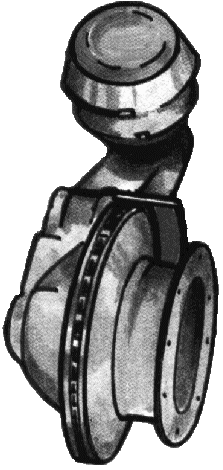
- Figure 1. Courtesy of the Government of the Province of British Columbia.
- Figure 1 illustrates a typical medium and heavy truck air operated disc brake. Adjustment is automatic. What causes disc brakes to drag? Several malfunctions are possible. The floating caliper, single piston design may have dirt built up on the guides and ways or these may have become corroded due to the protective lubricant loss. Lack of lubrication prevents the caliper from fully retracting when the brake pedal is released. Figure 2 illustrates a typical floating caliper disc brake.
- Figure2.
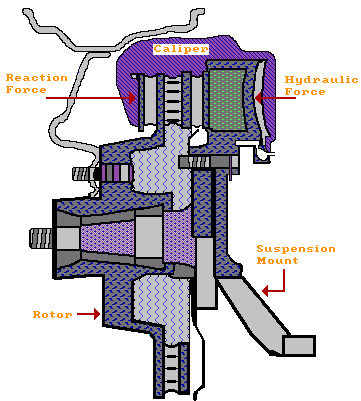
- On the hydraulically activated four piston non-floating design, the most likely culprit is contaminated brake fluid, dirt build-up, or corrosion on one or more of the pistons. The affected piston(s) will not retract fully upon brake release. The brake pad drags the rotor as a result.
- Figure 3 illustrates a typical four piston non-floating disc brake. Excessive corrosion or lack of proper lubrication of the dust boot(s) may cause four piston disc brakes to drag. Remember, a dragging disc pad causes reduced mpg and premature pad and/or rotor wear.
- Figure 3.
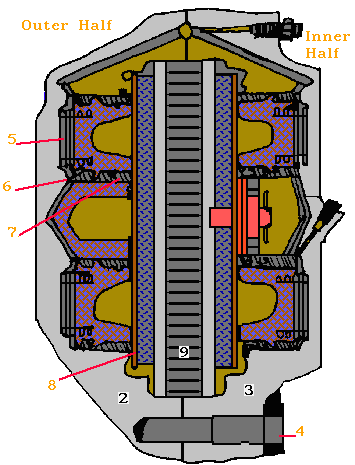
- 1. Caliper Assembly
- 2. Outboard Piston Housing (Caliper Half or Caliper Casting)
- 3. Inboard Piston Housing (Caliper Half or Caliper Casting)
- 4. Internal Fluid Passages
- 5. Piston Assembly
- 6. Piston Seal
- 7. Piston Boot (Dust Boot)
- 8. Shoe and Lining Assembly
- 9. Disc Brake Rotor
- Since the late 1980s, many heavy duty and extra heavy duty truck and trailer manufacturers have offered optional air operated disc brakes. Unlike the hydraulic versions, these brakes are used on all tractor axles, steering as well as driving. Trailer manufacturers now offer air operated disc brakes. The brake caliper design is similar to the single piston, floating caliper type in mounting, braking surface, action-reaction of the caliper and pad retention. Applied brake thrust force results from lever operated worm screw drive mechanism. Some axle design modifications are needed to mount the brake.
- On medium trucks which use the hydraulic design, the piston is mounted in the caliper and applies the force perpendicular to the rotor and directly to the inboard pad. An equal and opposite force is applied to the outboard pad as the caliper slides on the brake-mount ways. See the Figures 4a and 4b below.
- Figure 4a
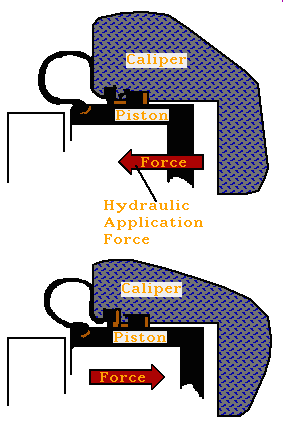
- Figure 4b
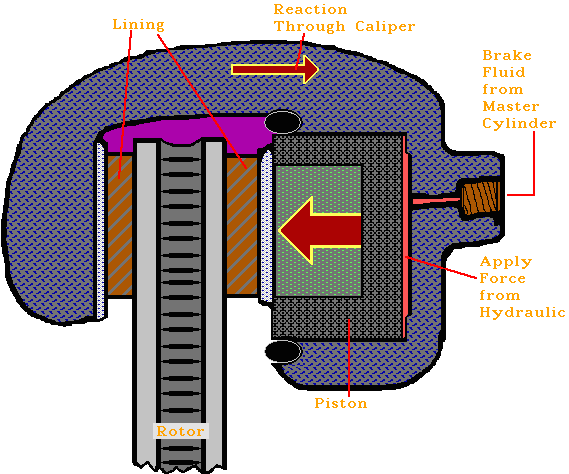
- Cross sectional view of single-piston caliper. Note that the hydraulic pressure pushes the piston outward and pulls the caliper inward.
- In the air actuated disc brake, the air piston operates a lever arm similar to an S-cam slack adjuster. The lineal motion of the piston is transmitted to the rotary shaft motion.
- The rotating shaft motion changes to lineal thrust via a rotary cam to a sliding cam device. Self adjustment is accomplished automatically to the adjuster nut and clutch assembly. The clutch torsion spring prevents adjuster nut back-off. See Figures 5A and 5B.
- Figure 5A
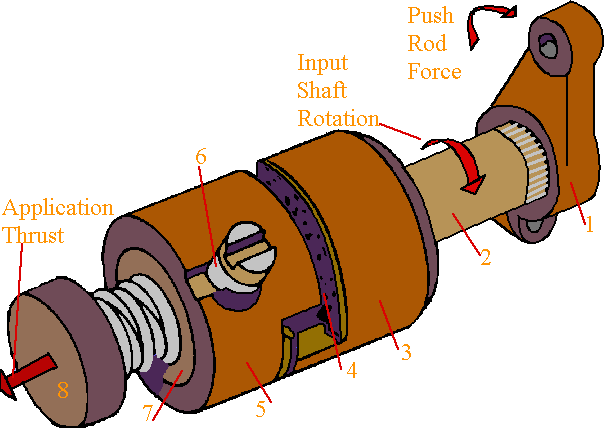
- 1. Lever Arm
- 2. Input Shaft
- 3. Rotary Cam
- 4. Roller Bearings
- 5. Sliding Cam
- 6. Lock Pin
- 7. Adjusting Nut
- 8. Thrust Spindle
- Figure 5B
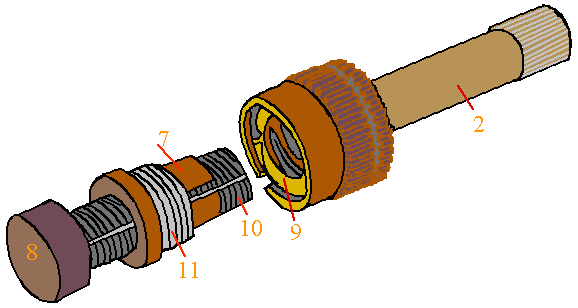
- 2. Input Shaft
- 7. Adjusting Nut
- 8. Thrust Spindle
- 9. Adjuster Clutch Assembly
- 10. Clearance Notch
- 11. Clutch Torsion Spring
- When considering the conservation of fuel and energy, this disc is no different than any other; a dragging disc pad will result in loss of fuel economy. However, the causes for a dragging air applied disc brake may not be the same as in a hydraulically applied disc brake. If a prematurely worn inboard pad is discovered, the problem could be the air chamber not releasing, the air valve not completely releasing or an actuator arm not correctly aligned.
- CAUTIONS:
- 1. DO NOT ATTEMPT TO OPEN OR DISASSEMBLE AIR BRAKE CHAMBERS; SERIOUS INJURY MAY RESULT.
- 2. ALTHOUGH THESE DIAPHRAGM STYLE AIR CHAMBERS LOOK LIKE THE S-CAM TYPE, DISC BRAKE CHAMBERS ARE DIFFERENT AND THEREFORE ARE NOT INTERCHANGEABLE WITH AN S-CAM CHAMBER!
- If both pads are wearing excessively on a single wheel or axle, check to see if the spring brake is fully releasing. A brake on another wheel or axle could not be adjusting due to a displaced, worn, or torn boot or lip seals on the adjusting mechanism.
- To assist in correct diagnosis:
- ALWAYS CONSULT THE MANUFACTURER'S SHOP MANUAL FOR EXACT DISC BRAKE ADJUSTMENT PROCEDURES.
- CAUTION:
- ALL BRAKE WORK HAS THE POTENTIAL FOR ASBESTOS HAZARDS. USE THE CORRECT EQUIPMENT AND PROCEDURES.
- How are these problems corrected? For external corrosion, dirt, or lack of lubrication, disassemble in accordance with manufacturer's shop manual procedures. Clean the parts with appropriate solvents. Inspect for wear, metal fatigue, and failure! Lubricate using the recommended lubricant and reassemble. If brake drag results from (a) piston(s) not fully retracting or improper operation of the air brake operating mechanism, caliper disassembly, inspection, and rebuilding will be necessary. Observe manufacturer's shop manual cautions. Note the bleed down procedures prior to disassembly for air, air over hydraulic, and hydroboost type systems.
- SUMMARY:
- Disc brake systems infrequently cause loss of fuel economy; however, disc brakes can and do drag resulting in reduced mpg and increased operating cost. Obvious indications of disc brake drag are:
- 1. Excessive wear of one brake pad (Note: it is normal for the inner pad of some single piston, floating types to have a slightly higher wear rate than the outer pad.)
- 2. Vehicle pull. If all alignments are within specification, a truck can still pull to one side if a disc brake drags.
- 3. Tapered pad wear. This failure is most common on the four piston fixed caliper type and is caused by one or more pistons failing to fully retract.
- 4. More pad wear on one wheel of an axle is a definite dragging brake indicator.
- ACTIVITY INSTRUCTIONS:
- WARNING:
- ALWAYS CONSULT THE MANUFACTURER'S SHOP MANUAL FOR EXACT BRAKE ADJUSTMENT PROCEDURES.
- CAUTION:
- ALL BRAKE WORK HAS THE POTENTIAL FOR ASBESTOS HAZARDS. USE THE CORRECT EQUIPMENT AND PROCEDURES.
- Report your findings on the Student Activity Report Sheet.
- 1. Locate a medium, heavy or extra heavy truck with disc brakes.
- 2. Determine type (air, hydraulic, or air over hydraulic) design and type.
- 3. Locate an appropriate manual to determine correct inspection procedure.
- 4. Block the wheels so the vehicle will not roll. Release the parking brake. If inspecting a drive axle, place transmission in neutral.
- 5. Raise the axle and place a safety stand at an appropriate place to support the weight of the vehicle.
- 6. Try to rotate the wheel and tire assembly by hand. If it does not move freely, remove the tire or wheel assembly and proceed to check disc brake.
- Using the shop manual as a guide, identify the type of disc brake and check for:
- A. Excessive pad wear
- B. Tapered pad wear
- C. Build up of dirt, corrosion, or lack of lubricant.
- If any of these are noted, inform your instructor and request permission to repair according to manufacturer's manual.
- If the wheel and tire assembly did turn freely and there was no abnormal wear on any one wheel, the disc brake is retracting correctly and no fuel is being wasted due to brake drag.
- Student Activity Report Sheet
- WARNING:
- ALWAYS CONSULT THE MANUFACTURER'S SHOP MANUAL FOR EXACT BRAKE ADJUSTMENT PROCEDURES.
- CAUTION:
- ALL BRAKE WORK HAS THE POTENTIAL FOR ASBESTOS HAZARDS. USE THE CORRECT EQUIPMENT AND PROCEDURES.
- Student Name(s):_______________________________________
- Date Started:________________ Date Completed: _______________
- 1.
- Year:_______________________
- Make: ______________________
- Model:______________________
- 2. Disc brakes are activated by: (check one)
- _________ Hydraulics
- _________ Air Over Hydraulics
- _________ Air Only
- 3. Disc brakes used on: (check one)
- _________ Front axle only
- _________ Front and rear axle(s)
- 4. What type of parking brake mechanism is used? Describe briefly:
- 5. Where were the safety stands placed? In the space below, make a top view sketch of the vehicle and indicate where the safety stands were placed.
- 6. A. Did each wheel equipped with a disc brake turn freely?
- If you checked NO, which one(s) did not turn freely?
- L.F. _____Yes - _____No
- R.F. ______Yes - ______No
- L.F.T._____ Yes - ______No
- R.F.T._____Yes - ______No
- L.R.T._____Yes - ______No
- R.R.T._____Yes - ______No
- B. For each wheel that did not turn freely, describe what condition existed (i.e. tapered pad wear, excessive inner paper wear, or excessive inner and outer wear).
- C. For each wheel that did not turn freely, was there excessive dirt, corrosion, or lack of lubricant on the ways, guide pins, and moving parts? Describe each wheel that did not turn freely.
- D. Instructors comments and repair approval: I approve the following repairs to this vehicle:
- Signature_________________________ Date _____________
- E. Student report: The following parts were replaced or repairs have been made on this vehicle (describe fully):
- F. Instructor's completed job inspection: This vehicle has been repaired by the above named student(s). I have checked the operation of these brakes and certify that they operate properly.
- Signature_________________________ Date _____________
- INFORMATION CHECK
- Indicate whether the statements below are true or false. If false, please correct to make it a true statement.
- 1._______ Disc brakes need no periodic adjustment.
- 2._______ One important disc brake difference is mounting type; they are either floating or fixed.
- 3._______ As long as the wheel turns freely, no drag is evident and therefore no adjustment is needed.
- 4._______ A weak air chamber return spring will cause a disc brake to drag.
- 5._______ Which of these disc brake problems will cause a decrease in mpg?
- A). Broken return spring
- B). Corrosion on the caliper-to-mount way
- C). Worn or improperly lubricated guide pins and sleeves
- D). All of A, B, and C
- 6._______ Air operated disc brakes operate the same as hydraulically operated disc brakes except that the air chamber replaces the hydraulic piston.
- TEACHER'S NOTES
- Excessively tight disc brakes cause vehicle pull, premature brake wear, and loss of mpg. A result is pad drag and reduced mpg. Even slight drag can reduce mpg. A nonreleasing pad will not only wear out faster but will reduce the vehicle's mpg. It is important that students realize that even though disc brakes are virtually trouble free, over a period of time lubricants get contaminated, dry out or are washed away resulting in a dragging pad. Disc brakes are becoming more popular for heavy trucks since they contribute a net reduction in vehicle weight and stop more efficiently.
- ANSWERS TO INFORMATION CHECK
- 1. True. Brakes do need to be checked periodically for pad drag due to other failures.
- 2. True.
- 3. True and False. Depends on the age and conditions vehicle is operated under. Off-road vehicles should be checked periodically.
- 4. True.
- 5. D. All apply.
- 6. False. Air operated disc brakes use a lever and rotary cam to gain the necessary added mechanical advantages to apply the pads to the rotor.
- RECOMMENDED READING:
- On Highway Trucks, pages 559-569
- Diesel Equipment I, pages 234-243
- Service Manual for Kelsey-Hayes Air Disc Brakes. Publication No. 4-1-4. Gunite Corporation. November, 1987.
- Fleet Equipment. November, 1992. Pages 18-24.
- REFERENCES:
- Brady, Robert N. On-Highway Trucks. Reston Publishing Co. Inc., Reston, VA. 1982.
- Schulz, Erich J. Diesel Equipment I. Gregg Division of McGraw Hill, New York. 1982.
- Kelsey-Hayes Air Disc Brakes. Form 2-1160. Gunite Corporation.
- Service Manual for Kelsey-Hayes Air Disc Brakes. Publication No. 4-1-4. Gunite Corporation. November, 1987.
- Fleet Equipment. October, 1992. Volume 18, Number 10. Brakes: An Update. Carol Birkland, Senior Editor
Comments or questions to: TechAsmt@LA.GOV
Return to Diesel Menu













